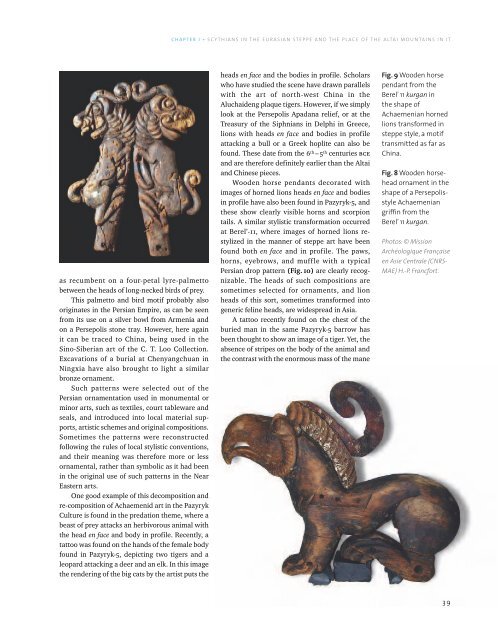Scythian Culture - Preservation of The Frozen Tombs of The Altai Mountains (UNESCO)
Create successful ePaper yourself
Turn your PDF publications into a flip-book with our unique Google optimized e-Paper software.
CHAPTER I • SCYTHIANS IN THE EURASIAN STEPPE AND THE PLACE OF THE ALTAI MOUNTAINS IN IT<br />
as recumbent on a four-petal lyre-palmetto<br />
between the heads <strong>of</strong> long-necked birds <strong>of</strong> prey.<br />
This palmetto and bird motif probably also<br />
originates in the Persian Empire, as can be seen<br />
from its use on a silver bowl from Armenia and<br />
on a Persepolis stone tray. However, here again<br />
it can be traced to China, being used in the<br />
Sino-Siberian art <strong>of</strong> the C. T. Loo Collection.<br />
Excavations <strong>of</strong> a burial at Chenyangchuan in<br />
Ningxia have also brought to light a similar<br />
bronze ornament.<br />
Such patterns were selected out <strong>of</strong> the<br />
Persian ornamentation used in monumental or<br />
minor arts, such as textiles, court tableware and<br />
seals, and introduced into local material supports,<br />
artistic schemes and original compositions.<br />
Sometimes the patterns were reconstructed<br />
following the rules <strong>of</strong> local stylistic conventions,<br />
and their meaning was therefore more or less<br />
ornamental, rather than symbolic as it had been<br />
in the original use <strong>of</strong> such patterns in the Near<br />
Eastern arts.<br />
One good example <strong>of</strong> this decomposition and<br />
re-composition <strong>of</strong> Achaemenid art in the Pazyryk<br />
<strong>Culture</strong> is found in the predation theme, where a<br />
beast <strong>of</strong> prey attacks an herbivorous animal with<br />
the head en face and body in pr<strong>of</strong>ile. Recently, a<br />
tattoo was found on the hands <strong>of</strong> the female body<br />
found in Pazyryk-5, depicting two tigers and a<br />
leopard attacking a deer and an elk. In this image<br />
the rendering <strong>of</strong> the big cats by the artist puts the<br />
heads en face and the bodies in pr<strong>of</strong>ile. Scholars<br />
who have studied the scene have drawn parallels<br />
with the art <strong>of</strong> north-west China in the<br />
Aluchaideng plaque tigers. However, if we simply<br />
look at the Persepolis Apadana relief, or at the<br />
Treasury <strong>of</strong> the Siphnians in Delphi in Greece,<br />
lions with heads en face and bodies in pr<strong>of</strong>ile<br />
attacking a bull or a Greek hoplite can also be<br />
found. <strong>The</strong>se date from the 6 th –5 th centuries bce<br />
and are therefore definitely earlier than the <strong>Altai</strong><br />
and Chinese pieces.<br />
Wooden horse pendants decorated with<br />
images <strong>of</strong> horned lions heads en face and bodies<br />
in pr<strong>of</strong>ile have also been found in Pazyryk-5, and<br />
these show clearly visible horns and scorpion<br />
tails. A similar stylistic transformation occurred<br />
at Berel’-11, where images <strong>of</strong> horned lions restylized<br />
in the manner <strong>of</strong> steppe art have been<br />
found both en face and in pr<strong>of</strong>ile. <strong>The</strong> paws,<br />
horns, eyebrows, and muffle with a typical<br />
Persian drop pattern (Fig. 10) are clearly recognizable.<br />
<strong>The</strong> heads <strong>of</strong> such compositions are<br />
sometimes selected for ornaments, and lion<br />
heads <strong>of</strong> this sort, sometimes transformed into<br />
generic feline heads, are widespread in Asia.<br />
A tattoo recently found on the chest <strong>of</strong> the<br />
buried man in the same Pazyryk-5 barrow has<br />
been thought to show an image <strong>of</strong> a tiger. Yet, the<br />
absence <strong>of</strong> stripes on the body <strong>of</strong> the animal and<br />
the contrast with the enormous mass <strong>of</strong> the mane<br />
Fig. 9 Wooden horse<br />
pendant from the<br />
Berel’ 11 kurgan in<br />
the shape <strong>of</strong><br />
Achaemenian horned<br />
lions transformed in<br />
steppe style, a motif<br />
transmitted as far as<br />
China.<br />
Fig. 8 Wooden horsehead<br />
ornament in the<br />
shape <strong>of</strong> a Persepolisstyle<br />
Achaemenian<br />
griffin from the<br />
Berel’ 11 kurgan.<br />
Photos: © Mission<br />
Archéologique Française<br />
en Asie Centrale (CNRS-<br />
MAE) H.-P. Francfort.<br />
39
















